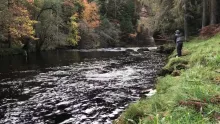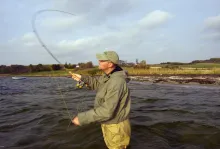The leader is an essential part of the fly fishing setup. This article tells you a bit about designing leaders
The Leader Concept
I'll give you the bottom line now: No matter how experienced you are in fly fishing, don't neglect the leader! It pays to know as much as you can about how your leader affects your cast and the presentation and drift of your fly. Just knowing the basics will give you more confidence in your ability to put the fly in front of the fish's nose. During a day of tough conditions in fly fishing, your choice of leader style can spell the difference between success and failure.
Tapered leaders, when designed properly, will present a fly in a stealthy, life-like manner to your quarry.
Proper selection of leaders for your fishing environment is the single-most important element in fooling fish to the take.
Leaders serve several purposes:
- Providing a nearly invisible connection between you and your offering
- Aiding in the proper presentation of the fly
- Allowing the fly to respond in a lifelike manner
- Transferring and dissipating the energy of the cast towards the fly
The fly line is designed to efficiently transmit and maintain the energy from the cast. In contrast, the leader is designed to absorb, disperse and transmit a smooth, but decreasing flow of energy to the fly.
Types of Tapered Leaders & Their Characteristics
There are literally thousands of leader designs. They can be roughly categorized in the following manner:
- Dry
- Stillwater or spring creek leaders. Long, limp, wispy, thin
- Nymph
- Streamer - straightens very rapidly and offers immediate control of the fly. A short, large diameter design made with tough, stiff materials is the ticket.
- Bass/Panfish – relatively short and stiff
- Pike/Muskie - made for toothy fishes
- Steelhead/Salmon - durability and strength are key
- Saltwater – Stiff, strong and abrasion resistant, transparency is less of an issue.
The length of the leader, the tippet size and the taper all play a vital role in the success of the leader "turning over" or delivering the fly to the target. Since a leader that optimally turns over a fly is the ideal goal, we can decipher that the taper is the single most critical element of the leader. But, like any puzzle, there are several solutions to an acceptable end result. To complicate the puzzle, there are many intangibles to consider when designing/tying a hand-made leader. Consider:
- Your casting speed and style
- The rod's action (fast, medium, slow)
- Length of required cast
- Wind conditions
- Water surface currents for dry fly and nymph fishing
- Sub-surface water currents for nymphing
- Water clarity
- Water depth
- Water temperature (affects the "stiffness" and pliability of the leader material)
- Underwater structure that may nick and abrade the leader material
- The quarry you are after (size, "toothyness",
fighting style, etc.) - The characteristics of the leader material (stiffness, suppleness, color, abrasive-resistance, etc.)
Given the many variables listed above and the countless variables in leader taper design, you can easily see where one could actually tie a leader for each specific pocket, run, riffle and pool in every stream you fish. Example: If I started upstream of a classic riffle/run/pocket/pool stream scenario where I wanted to fish dries, nymphs and streamers, I could theoretically be forced to use a minimum of 12 different leader combinations to fish that one stretch (4 streams sections, 3 ways to fish them each). But if I did that, I would spend more time tying on leaders and flies than actually casting to fish. Thus, the challenge to you is: it is your decision to find the optimum leader for your fishing conditions and styles. Is it possible to design a combination leader that serves many functions? Sure!
|
Table 1 |
||
| Line Weight | (mm's) Butt Diameter |
(inches) Butt Diameter |
| 3 | .45-.50 | .017"-.020" |
| 4 | .45-.55 | .019"-.021" |
| 5 | .50-.55 | .020"-.022" |
| 6 | .55-.60 | .021"-.023" |
| 7 | .60-.65 | .022"-.024" |
| 8 | .60-.65 | .023"-.026" |
| 9 | .60-.70 | .024"-.027" |
- Log in to post comments








Furled leaders, tip question
Hello, First let me say I love your website! It is a constant source of information for me.
So, my question is about tapered furled leaders, more so with tip diameter. If I look at the table of butt section diameters, at the end of this article, I can get the butt sections in the appropriate diameter, for example ca. .55mm for 5 wt.
But using the same material, my tip diameter is about .40mm which seems a bit much to tie on 0.14mm tippet.
No matter what diameter mono I use the leader tip always seems too large for tippet. The only solution I found until now is to do a two part furled leader, where I first furl 4 strands and then marry the 4 strands furled mono to the actual furled leader via loop to loop. The taper comes out to 22-18-14-10-6-4, when using the formula from this site.
Is the large jump in diameter ok, am I just being overpedantic? Should I tie tapers before tippet or is there any other trick to get a good taper from the tip of the furled leader to tippet?
Furled leader tips
Kristjan,
When I make furled leaders using mono I use very thin mono and usually end it in a loop. To this loop I attach a piece of mono and I then attach the tippet to that.
It's true that the tip of the furled leader is fairly thick when using mono - when ending with four strands it's of course four times the thickness of the line you furl. So the trick is to keep it thin, but even with a 0.10 mm line you will still end up with a 0.40 mm tips as you also mention, and will need a further "step" down.
I typically fish a 0.20 or 0.25 mm tippet in my fishing, so a piece of 0.30mm of about 30-50 cm will suffice to give a proper taper. I also use this piece as a "wear piece" that I can cut down when changing tippet, and exchange completely when it becomes too short.
For thinner tippets - like for stream fishing - I use furled leaders made from tying thread, in which case the tip is much thinner, and this problem rarely occurs.
I hope this helps
Martin